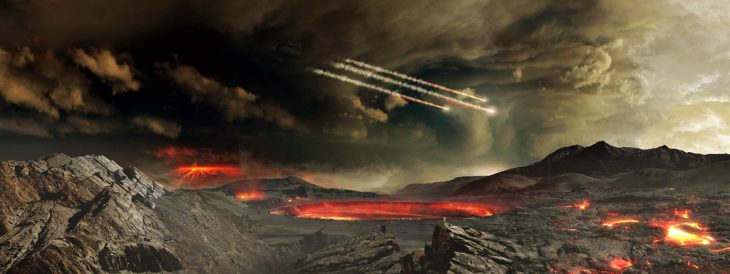Where do we come from? How did life originate on Earth? If you’ve ever looked up at the stars and wondered these questions, you aren’t alone. Astrobiologists wonder about these things, too!
Astrobiologists are interested in the ingredients that make life. All of life is composed of simple ingredients that have come together to form complex structures called biomolecules. There are four types of biomolecules — proteins (little “machines” that do most of the work inside a cell), carbohydrates (sugars), lipids (fats, steroids, waxes), and nucleic acids (DNA and RNA). Just these four biomolecules are responsible for creating the diversity of life on Earth. Determining the origin of the ingredients that come together to make life can bring us closer to understanding our own origin.
It turns out that early Earth did have access to the ingredients for biomolecules. Organic molecules like amino acids, which make up proteins, have been detected in samples of meteorites. This suggests the possibility that meteorites or ice-covered dust grains could have seeded Earth with the ingredients to make biomolecules. Scientists have also been working on non extra-terrestrial mechanisms to explain the origin of the ingredients. They have been able to create adenine (a component of nucleic acids) from various ingredients that were readily available on early Earth. Whether by extra-terrestrial means or not, early Earth had the ingredients to make biomolecules.
The next step in understanding the origin of life is to try and understand the processes that actually turn the ingredients into biomolecules. If you need life in order to make biomolecules, then how did the first biomolecules form? A pathway must have existed that allowed the ingredients to self-assemble into biologically important molecules. Astrobiologists at the Physical Research Laboratory, Indian Institute of Science, Indian Institute of Technology, International Space University, and the University of Kent published a paper that explains one way that biomolecules may have first assembled.
Early Earth went through a period of time where it was heavily bombarded by asteroids. The ingredients for making biological molecules likely went through repeated impact-driven shock processes. In a previous study amino acids were shown to survive these extreme conditions and also formed proteins as a result. This group of scientists wanted to see what effect these extreme conditions would have on the ingredients that make nucleic acids, which are called nucleobases.
They tested a mixture of nucleobases as well as individual nucleobases in a device called a shock tube. The nucleobase solutions were added to a reaction chamber at one end of the tube. High pressure helium gas was filled at the other end, which triggered a diaphragm to release a shock wave that traveled toward the end of the tube and reflected into the reaction chamber. The reflected shock wave superheats the samples for a few milliseconds, and as soon as the shock wave exits, the samples quickly cool. Multiple runs were conducted at temperatures ranging from 3740K to 6900K. The researchers collected the solid residue that was left behind in the reaction chamber to figure out what it was made of.
Using a scanning electron microscope to view the solid residue, the researchers found that many complex molecules had formed. The mixture of nucleobases from DNA were shocked at 3700K and produced globular structures with twisted filaments and folded threads. The DNA bases that were shocked at 6360K showed larger structures of long threads and twisted folds. Samples of nucleobases mixed with a sugar called ribose were shocked at 6900K and produced long threads with large clumped structures. Some of the threads were twisted and folded. Nucleobases from RNA were shocked at 6320K showed threads, but these weren’t as prominent as those produced from shocking DNA nucleobases. The single nucleobases of adenine and cytosine shocked at 4000K did not show any complex structures.
The researchers then analyzed the residue with a high-resolution transmission electron microscope (HRTEM). The DNA base mixture showed fine and folded features, and the RNA base mixture showed sheets with uniform twisted appearances. They then ran the mixtures and single nucleobases through an Infrared Spectroscope and found that all of the nucleobases had remained intact against the impact of the strong shock.
Given that the nucleobases were able to stay intact during the shock wave it is possible that the nucleobases self-assembled into these structures. However, in this study, the authors did not analyze the chemical make-up of the residue. They are saving that for a future study.
This study suggests that it’s possible for biomolecules to form when smaller organic compounds are shocked with a large amount of energy, perhaps from a asteroid hitting the Earth. This pathway doesn’t require any catalysts or previously living organisms. This study brings us another step closer to understanding the origin of life on Earth.


